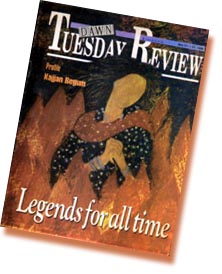
Search the Republic of Rumi |
|
Multi-Splendored Folklore Folk stories help exploring a people’s psyche. Since they all have come down to us with every generation, including its own biases and undertones, any folk story at any given moment of time can be taken as an opaque image of a collective consciousness. Work carried out by various scholars in this field highlights at least three significant functions of folk stories: spiritual, psychological and social. Spiritual Laila Majnun, Heer Ranjha, Sassi Punhoon, Sohni Mahinwal, Marvi are just some of the examples. The idea that the love of the opposite sex should be transmuted into a feeling of higher order is central to all eastern (especially Islamic) folk stories. It was perhaps derived from the great tale of Yousuf and Zulekha, a part of which has been related in the Holy Quran itself (Surah Yousuf). Although the Quran does not elaborate on how Zulekha’s love evolved into a feeling of the higher order, the mystic storytellers of the later generations found inspiration from some of the Quranic verses to show themselves that a simple yearning, such as that of Zulekha’s, can be transformed into a devotion to the Almighty. Quite a good many of these stories come close to being spiritual allegories. Annemarie Schimmel has shown, for instace, how the pattern of the folk tale of Sassi Punhoon can be explored to reveal the motifs of religious conversion, spiritual journey (sulook) and the search for a divine ideal. This spiritual dimension was always understood by the audience of the folk stories. In fact some of their authors had actually undergone incidents in their early lives that paralleled the stories they were going to write later. To name just two: Muhammad Seer of Shugram, Chitral and Shah Abdul Latif Bhittai. It is said that Seer was crossing a river through a narrow suspension bridge, one day, when he came face to face with his beloved who was coming along the same bridge from the opposite side. He was so intent on avoiding physical contact, that he jumped into the river and swam his way through. His poem Yar-e-Man Hameen is perhaps the greatest masterpiece of Chitrali literature. Shah Abdul Latif Bhittai fell in love with a lady far above him in social status. When the marriage was refused, he left home to wander in the desert. Finally the girl’s family conceded and called him back. But the young mystic had totally transformed by that time, so that even after getting married to the beloved, he could not take his heart away from the higher devotion. Finally he left the physical pleasures of home and returned to the life of an ascetic on the mound of Bhit. It is therefore, safe to assume that the spiritual message, even the allegorical characterization of our folk stories was quite deliberately placed by their authors and generally understood by the audience. Psychological Interestingly, in such stories as Sassi Punhoon and Marvi, the woman’s journey is just as significant as, if not more than, the journey of the man. Psychoanalysts like Sudhir Kakar and John M. Ross have tried to unearth the more mundane motifs which they think were buried in the unconscious of the authors. They point out that the young heroes or heroines of these stories always die in the end, especially the heroine. According to these psychoanalysts this was a warning from the patriarchies who could not compromise with social rebels. "Faithful to a lover freely chosen rather than to their marriage vows, loving in secrecy and concealment yet without shame or guilt, these heroines are examples and ideals of the capacity for choice that is possible for women even under restrictive social conditions. The price for this subjecthood is indeed cautionary: death. Yet the reward is equally momentous : the promise of the immortality attained in becoming ensconced in the pantheon of love’s legendary goddesses." (Tales of Love, Sex and Danger published by Oxford University Press, Delhi). The "spiritual dimension" mentioned above is also revisited by the psychoanalysts. Approaching the issue from an essentially secular point of view they have tried to explain the intrigues of love in terms of plain physical emotions. "The fascination of passionate loves des in its promise to resolve the inner paradoxes of two compelling and at times opposing enticing quests:
Sociological Lingering Tradition Sutherland rejects the divisions based upon time as a patriarchal bias. She maintains that South Asian societies are still closer to their past than the western societies. And therefore, in our case, it would not be appropriate to consider our legends "ancient". She says: "I would argue that, at least in my case and in others I know, we study not ancient, but traditional The difference is an important one. Because South Asian traditions are so deeply embedded in the modern, the region is to a large extent unique among living cultures of the world... Such stories as Ramayana and Mahabharata still provide a cultural identity for much of the population, as has clearly been evidenced recently by the popularity of Doordarshan’s serialization of the Ramayana. Is this story that has gripped a nation ancient or modern?" (Bridging Worlds, published by Oxford University Press, Delhi). This perspective brings us to the folk stories with a stronger sense of urgency and seriousness. If they are still as much relevant to us as they were to our ancestors, then a number of implications can be derived (some opposing the others):
| Work carried out by various scholars in this field highlights at least three significant functions of folk stories: spiritual, psychological and social. |
|||
